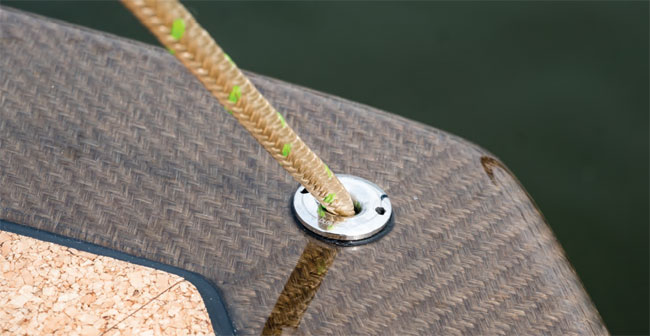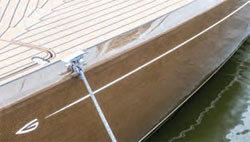

Sicomin have been in the green resin business for longer than you might think...
There is nothing new in the pursuit of environmentally friendly resins, at least not for Sicomin. Founded in 1983, the composites arm of this French company started creating green epoxies more than 10 years ago.
‘Our interest in green resins started well before it was in fashion,’ explains Sicomin’s president Phillippe Marcovich. ‘We started working with the ski and surf board markets where the end users, who were very much aware of the importance of their playgrounds in the mountains and at sea, already understood the need for environmentally friendly materials.
‘Over time, we proved our green credentials with epoxy products that clearly worked. This helped to create a growing number of customers who understood and believed in what we were doing, which in turn led to us into other areas.
‘Because it was still early days for this type of technology, we were conscious that we had to proceed carefully to avoid being perceived as trying to capitalise on the green agenda by developing materials that were environmentally cute. For example, we had been supplying a fire-retardant Epoxy gelcoat – SGi 128 – that is 38 per cent green to the civil engineering industry for several years, but we hadn’t made a big deal of this to avoid deflecting the attention away from the key fundamental properties that make our materials the best for the task.’
The reality is that for Sicomin’s Greenpoxy range, where an excess of 50 per cent of molecular structure derived from plant material is possible among some of the products, the technical performance and the cost are the same as those based solely on petrochemical derived products. Furthermore, the fact that Greenpoxy is available in industrial volumes and is the largest range of sustainable epoxy resins on the market today, drives the message home that these are resins that make no compromises and are already well accepted across many other markets.
‘Today we are involved in many areas beyond ski and surf including marine, automotive, renewable energy and civil engineering projects throughout Europe, the USA and Asia,’ he continues. ‘One marine user that has really impressed us recently has been Greenboats, especially with their Flax 27 day-sailer. This followed on from their GreenBente24 and has raised the bar while at the same time demonstrating once again their impressive commitment to producing an environmentally friendly boat.’

Greenboatsʼ Judel/Vrolijk designed Flax 27 is an impressively elegant modernclassic daysailer with equally impressive ecological credentials. The flax fibre hull is built with Sicominʼs InfuGreen and Greenpoxy 33 resins and its SD477x range of hardeners. As can be clearly seen above, the quality of finish is superlative. The hull is also just as strong as one thatʼs made with the finest petrochemical resins

Perhaps it should be of no surprise that the Judel/Vrolijk designed Flax 27 has turned so many heads since her launch at Boot Dusseldorf earlier this year, after all, she’s an elegant boat that strikes an impressive balance between modern and traditional styles. But her flax fibre and Greenpoxy laminate is what has drawn a good deal of attention.
Built using the infusion resin InfuGreen 810 and GreenPoxy 33 with different hardeners of the SD477x range being used for handlaminated parts, both materials are DNV-GL type approved – an important validation for Sicomin customers.
But the relationship between builder and supplier cuts both ways.
‘Since 2012, we have worked with more than a dozen different Bio Resin systems. Some with Bio Contents of up to 80 per cent,’ explains Greenboats’ founder and CEO, Friedrich Deimann. ‘However, from our perspective Sicomin has the most complete bio resin on the market today. But this doesn't come as a surprise because the company has also the most experience in this product category. We have been in contact with Sicomin since 2014 and the company has continuously invested in improving the product range.’
Michael Thon is also well versed in the reasons why Sicomin’s Greenpoxy is such a significant product going forwards. His company, Time Out Composites – Sicomin’s distribution partner in Germany and Austria since 2002 – was established 20 years ago to help builders choose the right composite materials for their tasks.
‘It is very important to be able to offer our clients a green epoxy that matches the mechanical properties of the conventional petrochemical products that they have been used to,’ he says. ‘They need to be able to work with the epoxy in the same way as well and in all these areas we know that Greenpoxy is a perfect match.’
In a sport that has seen some big steps forward as a result of developments in materials science, the price has often meant accepting compromises in other areas. In this regard, Greenpoxy is clearly different.
Marcovich says there is still more development to come with the possibility of resins with a far greater green content. But perhaps the most interesting affirmation as to why Greenpoxy is such an exciting new resin came in a simple comment: ‘If we didn’t label it green, you wouldn’t be able to tell the difference.’
Click here for more information on Sicomin »
We invite you to read on and find out for yourself why Seahorse is the most highly-rated source in the world for anyone who is serious about their racing.
To read on simply SIGN up NOW
Take advantage of our very best subscription offer or order a single copy of this issue of Seahorse.
Online at:
www.seahorse.co.uk/shop and use the code TECH20
Or for iPad simply download the Seahorse App at the iTunes store


